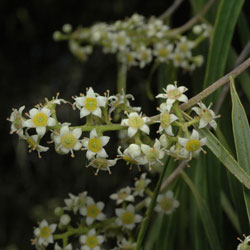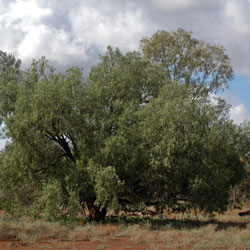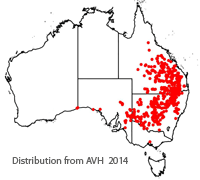Geijera parviflora
 |
 |
Wilga
Geijera parviflora Lindl.
 Geijera parviflora, or Wilga, is a hardy species in the Rutaceae family. It is distributed in dry areas with rainfall under 750mm per annum – primarily inland NSW, but also scattered in Qld, Vic, SA and WA. Its habitat is mainly mixed woodland communities, on lime-rich red clay loam or sandy soils with a variety of pHs. It is tolerant of 1–18 frosts per year, as well as drought, and if grown on well-drained soils can grow to 9 metres tall and live for 25 years.
Geijera parviflora, or Wilga, is a hardy species in the Rutaceae family. It is distributed in dry areas with rainfall under 750mm per annum – primarily inland NSW, but also scattered in Qld, Vic, SA and WA. Its habitat is mainly mixed woodland communities, on lime-rich red clay loam or sandy soils with a variety of pHs. It is tolerant of 1–18 frosts per year, as well as drought, and if grown on well-drained soils can grow to 9 metres tall and live for 25 years.
The dark, glossy leaves of Geijera parviflora are strongly scented when crushed, are long and thin (linear - up to 18 cm long), and are arranged alternately on the short stems. The bark is rough and also pleasant smelling. Flowers are small, white and five-petalled and emit a foetid smell to attract blowflies for pollination. Other insects (e.g. butterflies, lady beetles) and birds (e.g. wrens, bower birds) readily utilise this tree. Flowering occurs in June–November, followed by fruiting in January to May. The fruit is round and contains a single shiny black seed within the thick outer skin.
Fodder trees can be used for agricultural purposes to feed livestock, and can contain protein, energy, nutrients and vitamins that may be deficient in native grasses. Readily eaten by sheep, although rarely by cattle, Geijera parviflora, is often seen in a paddock trimmed to sheep height. Just under 1 kg of fodder per day is adequate to maintain a sheep not nursing a lamb. Although considered one of the most palatable species in eastern Australia, palatability does vary between individual plants, even in the same stand. The reason for this is not known, but it is postulated that minute soil differences, fire or the ploughing regime are the cause. This species also provides a great windbreak and shade, which is important for lambing ewes.
Other benefits of growing Geijera parviflora are that it yields a dark amber honey, with a very strong flavour, and that burning its foliage drives away mosquitoes. Due to its limited height, beautiful form (resembling a weeping willow) and as an evergreen, G. parviflora is highly sought after for parks and gardens. Propagation is extremely difficult, with fracturing and removing the seed coat (with a hammer), then sowing the seed when it is still fresh being the recommended method.
Geijera parviflora is extremely hardy once established. It grows best in a position of full sun, and while typical of drier climates, two specimens in the Australian National Botanic Gardens are growing in relatively damp soil and thriving. Pruning when young for a nice shape is recommended, as well as removing dead branches underneath. Wax scale may affect G. parviflora in coastal areas; however spraying in midsummer is an easy and effective treatment.
Text by Olivia Leal-Walker (2014 Student Botanical Intern)
Name meaning: Geijera parvifloraGeijera – after J.D. Geijer, a Swedish botanist of the late 1600s. parviflora – ‘parvus’ meaning small, and ‘floris’ meaning flower |
References:
Andrews, G. (1998) The Use of Trees and Shrubs for Livestock Production. Australian Biologist 11(2). Available at http://www.grahamandrews.com/fodder_trees.html [Accessed Feb 2014].
AVH, (2014) Geijera parviflora, Australia’s Virtual Herbarium, Council of Heads of Australasian Herbaria, http://avh.ala.org.au/occurrences/search?taxa=Geijera+parviflora#tab_mapView [Accessed Feb 2014]
Brereton, J., Fitzgibbon, J., May, P. & Will., J. (2009) Geijera parviflora. Metro Trees, Victoria. Available at http://www.metrotrees.com.au/treehandbook/page-listings/geijera-parviflora.html [Accessed Feb 2014]
Cremer, K.W. (1990) Trees for Rural Australia. Inkata Press Pty Ltd.
Cunningham, G.M., Mulham, W.E., Milthorpe, P.L. & Leigh, J.H. (1981) Plants of Western New South Wales, first edition. Soil Conservation Service of New South Wales, NSW Government Printing Office, Sydney.
Department of Agriculture, Fisheries and Forestry. (2012) Fodder trees for beef cattle feeding. Available at http://www.daff.qld.gov.au/environment/drought/managing-drought/drought-strategies/fodder-trees-for-survival-feeding-of-beef-cattle [Accessed Feb 2014]
Department of Industry and Investment, NSW. (Undated) Paddock Plants: Wilga. Available at http://www.dpi.nsw.gov.au/agriculture/resources/private-forestry/paddock-plants/Geijera-parviflora-Wilga.pdf [Accessed Feb 2014]
Everist, S.L. (1969) Use of fodder trees and shrubs. Queensland Department of Primary Industries Division of Plant Industry Advisory Leaflet No. 1024.
Hadlington, P. & Johnston, J. (1988) Australian trees: their care and repair, second edition. University of New South Wales Press Ltd.
Hall, N.H., Boden, R.W., Christian, C.S., Condon, R.W., Dale, F.A., Hart, A.J., Leigh, J.H., Marshall, J.K., McArthur, A.G., Russell, V. & Turnbull, J.W. (1972) The use of trees and shrubs in the dry country of Australia. Australian Government Publishing Service, Canberra.
Porteners, M.F. (1991) Geijera parviflora Lindl. PlantNET - The Plant Information Network System of The Royal Botanic Gardens and Domain Trust, Sydney, Australia (version 2.0). Available at http://plantnet.rbgsyd.nsw.gov.au/cgi-bin/NSWfl.pl?page=nswfl&lvl=sp&name=Geijera~parviflora [Accessed Feb 2014]
![An Australian Government Initiative [logo]](/images/austgovt_brown_90px.gif)

